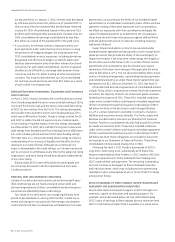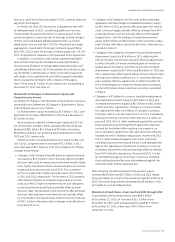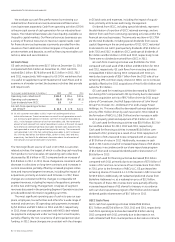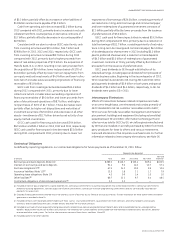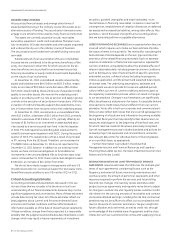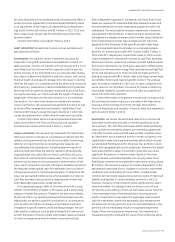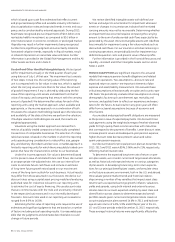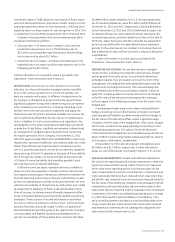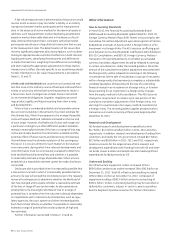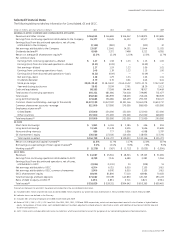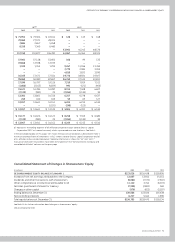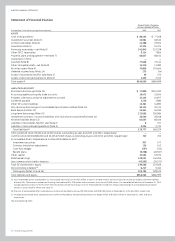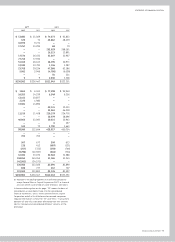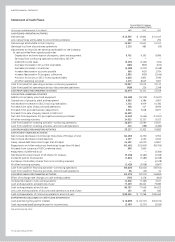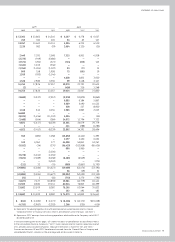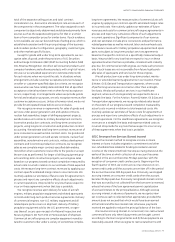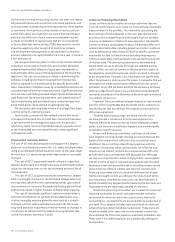GE 2013 Annual Report Download - page 70
Download and view the complete annual report
Please find page 70 of the 2013 GE annual report below. You can navigate through the pages in the report by either clicking on the pages listed below, or by using the keyword search tool below to find specific information within the annual report.’
68 GE 2013 ANNUAL REPORT
A fair value measurement is determined as the price we would
receive to sell an asset or pay to transfer a liability in an orderly
transaction between market participants at the measurement
date. In the absence of active markets for the identical assets or
liabilities, such measurements involve developing assumptions
based on market observable data and, in the absence of such
data, internal information that is consistent with what market
participants would use in a hypothetical transaction that occurs
at the measurement date. The determination of fair value often
involves signifi cant judgments about assumptions, such as deter-
mining an appropriate discount rate that factors in both risk and
liquidity premiums, identifying the similarities and differences
in market transactions, weighting those differences accordingly
and then making the appropriate adjustments to those market
transactions to refl ect the risks specifi c to our asset being valued.
Further information on fair value measurements is provided in
Notes 1, 21 and 22.
OTHER LOSS CONTINGENCIES are uncertain and unresolved mat-
ters that arise in the ordinary course of business and result from
events or actions by others that have the potential to result in
a future loss. Such contingencies include, but are not limited
to, environmental obligations, litigation, regulatory proceed-
ings, product quality and losses resulting from other events
and developments.
When a loss is considered probable and reasonably estima-
ble, we record a liability in the amount of our best estimate for
the ultimate loss. When there appears to be a range of possible
costs with equal likelihood, liabilities are based on the low end
of such range. However, the likelihood of a loss with respect to
a particular contingency is often diffi cult to predict and deter-
mining a meaningful estimate of the loss or a range of loss may
not be practicable based on the information available and the
potential effect of future events and decisions by third parties
that will determine the ultimate resolution of the contingency.
Moreover, it is not uncommon for such matters to be resolved
over many years, during which time relevant developments and
new information must be continuously evaluated to determine
both the likelihood of potential loss and whether it is possible
to reasonably estimate a range of possible loss. When a loss is
probable but a reasonable estimate cannot be made, disclosure
is provided.
Disclosure also is provided when it is reasonably possible that
a loss will be incurred or when it is reasonably possible that the
amount of a loss will exceed the recorded provision. We regularly
review all contingencies to determine whether the likelihood of
loss has changed and to assess whether a reasonable estimate
of the loss or range of loss can be made. As discussed above,
development of a meaningful estimate of loss or a range of
potential loss is complex when the outcome is directly dependent
on negotiations with or decisions by third parties, such as regu-
latory agencies, the court system and other interested parties.
Such factors bear directly on whether it is possible to reasonably
estimate a range of potential loss and boundaries of high and
low estimates.
Further information is provided in Notes 2, 13 and 24.
Other Information
New Accounting Standards
In March 2013, the Financial Accounting Standards Board
(FASB) issued Accounting Standards Update (ASU) No. 2013-05,
Foreign Currency Matters (Topic 830): Parent’s Accounting for the
Cumulative Translation Adjustment upon Derecognition of Certain
Subsidiaries or Groups of Assets within a Foreign Entity or of an
Investment in a Foreign Entity. The ASU resolves confl icting guid-
ance between Accounting Standards Codifi cation (ASC) Subtopics
810-10, Consolidation, and 830-30, Foreign Currency Matters—
Translation of Financial Statements, on whether accumulated
currency translation adjustments should be released to earnings
in certain circumstances. Under the revised guidance, the entire
amount of the cumulative translation adjustment associated with
the foreign entity will be released into earnings in the following
circumstances: (a) the sale of a subsidiary or group of net assets
within a foreign entity that represents a complete or substantially
complete liquidation of that entity, (b) the loss of a controlling
fi nancial interest in an investment in a foreign entity, or (c) when
the accounting for an investment in a foreign entity changes
from the equity method to full consolidation. The ASU does not
change the requirement to release a pro rata portion of the
cumulative translation adjustment of the foreign entity into
earnings for a partial sale of an equity method investment in
a foreign entity. The revised guidance applies prospectively to
transactions or events occurring in fi scal years beginning after
December 31, 2013.
Research and Development
GE-funded research and development expenditures were
$4.7 billion, $4.5 billion and $4.6 billion in 2013, 2012 and 2011,
respectively. In addition, research and development funding from
customers, principally the U.S. government, totaled $0.7 billion,
$0.7 billion and $0.8 billion in 2013, 2012 and 2011, respectively.
Aviation accounts for the largest share of GE’s research and
development expenditures with funding from both GE and exter-
nal funds. Power & Water and Healthcare also made signifi cant
expenditures funded primarily by GE.
Orders and Backlog
GE infrastructure equipment orders increased 14% to
$60.6 billion and services orders increased 1% to $43.8 billion at
December 31, 2013. Total GE infrastructure backlog increased
16% to $244.1 billion at December 31, 2013, composed of
equipment backlog of $63.9 billion and services backlog of
$180.2 billion. Orders constituting backlog may be cancelled or
deferred by customers, subject in certain cases to penalties.
See the Segment Operations section for further information.




